Analysis of the Influence of Silty Sands Moisture Content and Impact Velocity in SHPB Testing on Their Compactability and Change in Granulometric Composition
Abstract
1. Introduction
- ➣
- Use of laser particle size analyzer to determine the grain size composition of the soil sample (grain size curve)—a more accurate method due to the wide range of possibilities for 0.01 µm to 3500 µm grain diameters testing compared to classic sieve analysis (gradation test) and aerometric analysis methods.
- ➣
- Two types of silty sand with different contents of fine fractions were used for the study—fSi+Cl,1 = 15.14% and fSi+Cl,2 = 20.48%. The manuscript also has a practical (not only academic) aspect because the two types of silty sand studied were from the construction site of two different construction critical infrastructure facilities in Poland—the soil samples taken were really existing in the subsoil.
- ➣
- The study was conducted for a number of variants of soil samples depending on the variables, the impact velocity of the loading bar projectile for SHPB pneumatic launcher pressures, and moisture content of the sample (below and above the optimum moisture content) in order to create several potential sets of conditions for the use of this soil as, for example, ground protection layers loaded by dynamic action.
- ➣
- Repeatable trends in changes in the granulometric composition of soil samples were observed and shown graphically on grain size curves. The largest percentage change in granulometric composition through an increase in the value of the silt and clay fraction relative to the reference sample fSi+Cl for both types of silty sand tested occurs for the same moisture content variant w2 = 5%—for soil fSi+Cl,1 = 15.14%, there is an increase in the fine fraction of 11.08%, and for soil fSi+Cl,2 = 20.48%, there is an increase in the fine fraction of 15.17%.
2. Characteristics of Soil Samples
3. Test Stand and General Experimental Methodology
3.1. Description and Components of the Test Stand
- ❶—pneumatic bar projectile launcher [51];
- ❷—design to ensure that the bars are axially aligned with each other;
- ❸—bar projectile guide (launcher barrel);
- ❹—bar projectile;
- ❺—initiating bar;
- ❻—set of measuring strain gauges;
- ❼—soil sample casing (rigid ring);
- ❽—soil sample under test;
- ❾—transmitting bar;
- ❿—damper (impact-absorbing element);
- ⓫—bar projectile speed measurement kit v0;
- ⓬—digital recorder with computer.
- ①—main analyzer core;
- ②—measuring chamber system (water–soil mixture input–output);
- ③—circulation tank;
- ④—circulation and dispersion system of the water–soil mixture;
- ⑤—distilled water tank;
- ⑥—computer with dedicated software.
3.2. General Methodology for Conducting the Experiment
3.3. Process of Preparing a Soil Sample for Testing
- ❶—base cork;
- ❷—soil sample casing (rigid ring);
- ❸—sily sand sample;
- ❹—fixing screws;
- ❺—pressure plate;
- ❻—sinker 1000 g.
4. Test Results in the Laser Particle Size Analyzer
- for the first type of soil sample—fSi+Cl,1 = 15.14%:
- ➣
- Figure 12a with variable configuration values w1 = 0% and p1 = 1.2 bar (v1 = 12.76 m/s)–p2 = 1.8 bar (v2 = 17.69 m/s)–p3 = 2.4 bar (v3 = 21.32 m/s);
- ➣
- Figure 12b with variable configuration values w2 = 5% and p1 = 1.2 bar (v1 = 12.76 m/s)–p2 = 1.8 bar (v2 = 17.69 m/s)–p3 = 2.4 bar (v3 = 21.32 m/s);
- ➣
- Figure 12c with variable configuration values w3 = 10% and p1 = 1.2 bar (v1 = 12.76 m/s)–p2 = 1.8 bar (v2 = 17.69 m/s)–p3 = 2.4 bar (v3 = 21.32 m/s);
- ➣
- Figure 12d with variable configuration values w4 = 15% and p1 = 1.2 bar (v1 = 12.76 m/s)–p2 = 1.8 bar (v2 = 17.69 m/s)–p3 = 2.4 bar (v3 = 21.32 m/s);
- for the second type of soil sample—fSi+Cl,2 = 20.48%:
- ➣
- Figure 13a with variable configuration values w1 = 0% and p1 = 1.2 bar (v1 = 12.76 m/s)–p2 = 1.8 bar (v2 = 17.69 m/s)–p3 = 2.4 bar (v3 = 21.32 m/s);
- ➣
- Figure 13b with variable configuration values w2 = 5% and p1 = 1.2 bar (v1 = 12.76 m/s)–p2 = 1.8 bar (v2 = 17.69 m/s)–p3 = 2.4 bar (v3 = 21.32 m/s);
- ➣
- Figure 13c with variable configuration values w3 = 10% and p1 = 1.2 bar (v1 = 12.76 m/s)–p2 = 1.8 bar (v2 = 17.69 m/s)–p3 = 2.4 bar (v3 = 21.32 m/s);
- ➣
- Figure 13d with variable configuration values w4 = 15% and p1 = 1.2 bar (v1 = 12.76 m/s)–p2 = 1.8 bar (v2 = 17.69 m/s)–p3 = 2.4 bar (v3 = 21.32 m/s).
5. Discussion
- ➣
- Each silty sand sample used on the SHPB test stand achieved a higher proportion of fine fractions (silt and clay) in its granulometric composition after the test compared to the reference sample. Each dynamic impact with the bar projectile resulted in an increase in the value of the silt and clay fraction fSi+Cl—there was a phenomenon of destruction of the soil skeleton through grain breaking and an increase in the percentage of smaller-diameter grains. The correctness of Equations (4) and (5) can be seen:
- ➣
- For a given moisture content of a soil sample, there was a trend towards an increase in the proportion of the silt and clay fraction in the granulometric composition with an increase in the initially applied pressure of the pneumatic launcher to start the bar projectile movement. The trend in the behavior of the sample occurred as the impact velocity of the bar projectile increased, which can be represented by Equations (6)–(9):
- ➣
- As the moisture content of the soil sample increased, there was no simple relationship of change in the proportion of the silt and clay fraction in the granulometric composition (only an increasing relationship or only a decreasing relationship). For the moisture content of soil samples, w1 and w2 (values below the optimum moisture content wopt) for a given initial pressure of the pneumatic launcher (given impact velocity), a tendency towards an increase in the value of the silt and clay fraction was apparent (there was no significant effect of water on the test results). The higher the moisture content of the soil sample (in particular for w3 and w4 values above the optimum moisture content wopt), the stronger the trend of a decreasing value of the silt and clay fraction in the granulometric composition of the silty sand sample could be seen. There was a clear, dynamic response of the water filling the soil pores—the water gave the sample some characteristics of an elastic material and “damped” the dynamic impact of the bar projectile impact. This interaction had the effect of reducing the phenomenon of destruction of the soil skeleton by grain fracture, which can be represented in Equations (10)–(12):
- ➣
- Table 6 shows the percentage changes in silt and clay fraction as a consequence of bar projectile impact during the SHPB test compared to the reference sample, depending on the configuration of the variables—soil sample moisture content wi and initial shot pressure pi (impact velocity vi). For the first type of soil sample fSi+Cl,1 = 15.14%, the bar projectile impact load was most significant at a launching pressure p2 = 1.8 bar for all moisture content variants w1 ÷ w4 (particularly prominent values are for samples with moisture content w1 and w2 lower than the optimum moisture content wopt—for moisture content w3 and w4 higher than the optimum moisture content wopt, there is a phenomenon of “damping” of the impact through the reaction of water in the soil pores). At this pressure p2, the greatest percentage change in granulometric composition occurred through an increase in the value of the silt and clay fraction in relation to the reference sample fSi+Cl,1:
- ▪
- fSi+Cl,1 = 15.14% → fSi+Cl,1-III = 25.10% (increase of 9.96%);
- ▪
- fSi+Cl,1 = 15.14% → fSi+Cl,1-VI = 26.22% (increase of 11.08%);
- ▪
- fSi+Cl,1 = 15.14% → fSi+Cl,1-IX = 22.96% (increase of 7.82%);
- ▪
- fSi+Cl,1 = 15.14% → fSi+Cl,1-XII = 21.24% (increase of 6.10%).
- ▪
- fSi+Cl,2 = 20.48% → fSi+Cl,2-III = 32.87% (increase of 12.39%);
- ▪
- fSi+Cl,2 = 20.48% → fSi+Cl,2-VI = 35.65% (increase of 15.17%);
- ▪
- fSi+Cl,2 = 20.48% → fSi+Cl,2-IX = 25.79% (increase of 5.31%);
- ▪
- fSi+Cl,2 = 20.48% → fSi+Cl,2-XII = 25.35% (increase of 4.87%).
- ▪
- Parallelism of the contact surface between the soil sample-initiating bar and the transmitting bar. There is a particular risk of the parallelism condition not being achieved as a result of the compaction process of the soil sample. Silty sand is a loose material and susceptible to shape change. Applying the pressure plate elements in a way that is not perpendicular to the wall edge of the soil sample casing (rigid ring) will result in non-parallelism of the contact surface between the soil sample-initiating bar and transmitting bar (i.e., there will be a local air void). Consequently, incorrect waveform data will be recorded for the reflected wave (as a result of non-parallelism of the contact surface between soil sample-initiating bar) and transmitted wave (as a result of non-parallelism of the contact surface between the soil sample-transmitting bar).
- ▪
- Cohesive effect resulting from the internal structure of the tested soil sample. Silty sand is not a pure representative of sand containing only grains with a diameter in the range of 0.063 mm–2 mm (according to Figure 1). Silty sand has fine fractions below the limit of 0.063 mm—these give the soil sample cohesive characteristics, and the cohesion value is not zero. In simplification, it can be assumed that the more the fine fraction, the higher the cohesion value. According to the data in Table 6, it can be seen that the cohesion effect is not the only important factor influencing the results—the pore water content of the soil should be taken into account.
- ▪
- Interfacial friction effect is a widely discussed issue for the various materials tested in the SHPB test stand, particularly loose materials [61,62,63]. The incident wave created by the impact passes from the initiating bar to the soil sample during its propagation. The wave passes through a soil sample with a non-uniform and variable cross-section, which will result in an uneven stress distribution in the axial direction of the sample due to the interfacial friction effect.
6. Conclusions
- Each dynamic impact with the bar projectile results in an increase in the value of the silt and clay fraction fSi+Cl (there is a phenomenon of destruction of the soil skeleton through the breaking of grains and an increase in the percentage of grains with a smaller diameter).
- As the value of the initially applied pressure of the pneumatic launcher to start the bar projectile movement increases, there is a noticeable trend towards an increase in the proportion of the silt and clay fraction in the granulometric composition of the sample.
- For soil samples with a moisture content of w1 = 0% and w2 = 5% (values below the optimum moisture content of wopt,1 = 8.70% and wopt,2 = 9.20% depending on the type of sample) for a given initial pressure of the pneumatic launcher, a tendency towards an increase in the values of the silt and clay fraction is apparent (there is no significant effect of water on the test results). The higher the moisture content of the soil sample (in particular for values w3 = 10% and w4 = 15% above the optimum moisture content wopt,1 = 8.70% or wopt,2 = 9.20% depending on the type of sample), the stronger the trend towards a decreasing value of the silt and clay fraction in the granulometric composition of the silty sand sample. There is a noticeable dynamic response of the water filling the soil pores—the water gives the sample the characteristics of an elastic material and “dampens” the dynamic impact of the bar projectile. This interaction of water in the sample has the effect of reducing the destruction of the soil skeleton through grain fracture.
- For the first type of soil sample fSi+Cl,1 = 15.14%, the most significant is the bar projectile impact at an initial launcher pressure p2 = 1.8 bar for all sample moisture contents variants w1 ÷ w4—at this pressure p2, the greatest percentage change in granulometric composition occurs through an increase in the value of the silty and clay fraction fSi+Cl,1-k relative to the reference sample fSi+Cl,1. On the other hand, for the second type of soil sample fSi+Cl,2 = 20.48%, the greatest percentage change in granulometric composition occurs with a bar projectile impact at an initial launcher pressure p3 = 2.4 bar for all moisture content variants w1 ÷ w4—at this pressure p3, the greatest percentage change in granulometric composition occurs through an increase in the value of the silty and clay fraction fSi+Cl,2-k relative to the reference sample fSi+Cl,2.
Author Contributions
Funding
Institutional Review Board Statement
Informed Consent Statement
Data Availability Statement
Conflicts of Interest
Nomenclature
| wi | moisture content of soil sample—moisture variant no. i |
| pi | pneumatic launcher pressures—pressure variant no. i |
| vi | velocity of the bar projectile at the moment of impact with the initiating bar—velocity variant no. i |
| wopt,i | optimum moisture content value—variant of soil sample type no. i |
| fSi+Cl,i | content of fine fractions with a grain diameter of less than 63 µm (as the sum of silt and clay fractions)—variant of soil sample type no. i |
| fSa | sandy fraction content |
| fSi | silty fraction content |
| fCl | clay fraction content |
| ρd,max | maximum volumetric density of the soil skeleton |
| incident wave generates deformations in the initiating bar | |
| transmitted wave generates deformations in the transmitting bar | |
| reflected wave generates deformations in the initiating bar | |
| length of soil sample tested | |
| diameter of soil sample tested | |
| Poisson’s ratio of soil sample tested | |
| fSi+Cl,i-k | content of fine fractions with a grain diameter of less than 63 µm (as the sum of silt and clay fractions)—variant of soil sample type no. i for the variant variables during experiment no. k |
| Δ fSi+Cl,i-k − fSi+Cl,i | percentage change in granulometric composition through an increase in the value of the silty and clay fraction fSi+Cl,i-k relative to the reference sample fSi+Cl,i |
References
- Kang, D.; Noh, H.-G.; Kim, J.; Lee, K. Inverse Identification of a Constitutive Model for High-Speed Forming Simulation: An Application to Electromagnetic Metal Forming. Materials 2022, 15, 7179. [Google Scholar] [CrossRef] [PubMed]
- Cieplak, K.; Janiszewski, J.; Grązka, M.; Konwerski, Ł. Planar Shear Specimens for High Strain-Rate Testing of Engineering Materials Using the Conventional SHPB Technique: Experimental and Numerical Studies. Phys. Sci. Forum 2022, 4, 13. [Google Scholar] [CrossRef]
- Brodova, I.; Yolshina, L.; Razorenov, S.; Rasposienko, D.; Petrova, A.; Shirinkina, I.; Shorokhov, E.; Muradymov, R.; Garkushin, G.; Savinykh, A. Effect of Grain Size on the Properties of Aluminum Matrix Composites with Graphene. Metals 2022, 12, 1054. [Google Scholar] [CrossRef]
- Wang, H.; Zhang, Y.; Tan, Z. Dynamic Response and Deformative Mechanism of the Shape Memory Polymer Filled with Low-Melting-Point Alloy under Different Dynamic Loads. Polymers 2023, 15, 423. [Google Scholar] [CrossRef] [PubMed]
- Lagdani, O.; Tarfaoui, M.; Rouway, M.; Laaouidi, H.; Sbai, S.J.; Amine Dabachi, M.; Aamir, A.; Nachtane, M. Influence of Moisture Diffusion on the Dynamic Compressive Behavior of Glass/Polyester Composite Joints for Marine Engineering Applications. J. Compos. Sci. 2022, 6, 94. [Google Scholar] [CrossRef]
- Hu, F.; Gao, J.; Zhang, B.; Qi, F.; Zhao, N.; Ouyang, X. Effects of Modified Al2O3-Decorated Ionic Liquid on the Mechanical Properties and Impact Resistance of a Polyurethane Elastomer. Materials 2021, 14, 4712. [Google Scholar] [CrossRef]
- Shi, B.; Xing, H.; Mu, C.; Li, J.; Xu, T.; Liu, W. Analysis of Optimal Loading Angle in Dynamic Flattened Brazilian Disc Splitting Test for Concrete. Appl. Sci. 2022, 12, 11834. [Google Scholar] [CrossRef]
- Guo, L.; Guo, R.; Yan, Y.; Zhang, Y.; Wang, Z.; Mu, Y. Dynamic Compression Mechanical Properties of Polyoxymethylene-Fiber-Reinforced Concrete. Materials 2022, 15, 7784. [Google Scholar] [CrossRef]
- Wang, W.; Zhang, Z.; Huo, Q.; Song, X.; Yang, J.; Wang, X.; Wang, J.; Wang, X. Dynamic Compressive Mechanical Properties of UR50 Ultra-Early-Strength Cement-Based Concrete Material under High Strain Rate on SHPB Test. Materials 2022, 15, 6154. [Google Scholar] [CrossRef]
- Zhang, K.; Wang, F.; Yang, B.; Li, L.; Gao, L.; Sun, Y.; Guo, F. Mechanical Response and Failure Mechanisms of Natural Bamboo Fiber Reinforced Poly-Benzoxazine Composite Subjected to Split-Hopkinson Tensile Bar Loading. Polymers 2022, 14, 1450. [Google Scholar] [CrossRef]
- Nachtane, M.; Tarfaoui, M.; Ledoux, Y.; Khammassi, S.; Leneveu, E.; Pelleter, J. Experimental Investigation on the Dynamic Behavior of 3D Printed CF-PEKK Composite under Cyclic Uniaxial Compression. Compos. Struct. 2020, 247, 112474. [Google Scholar] [CrossRef]
- Li, R.; Liu, L.; An, H.; Wang, Y. Study on Dynamic Constitutive Model of Polypropylene Concrete under Real-Time High-Temperature Conditions. Appl. Sci. 2022, 12, 1482. [Google Scholar] [CrossRef]
- Williams, O.; Taylor, S.; Lester, E.; Kingman, S.; Giddings, D.; Eastwick, C. Applicability of Mechanical Tests for Biomass Pellet Characterisation for Bioenergy Applications. Materials 2018, 11, 1329. [Google Scholar] [CrossRef]
- Bragov, A.M.; Iuzhina, T.N.; Lomunov, A.K.; Igumnov, L.A.; Belov, A.A.; Eremeyev, V.A. Investigation of Wood Properties at Elevated Temperature. J. App. Comp. Mech. 2022, 8, 298–305. [Google Scholar] [CrossRef]
- Kruszka, L.; Sobczyk, K. Applications of Hopkinson Bar Technique for Capability Testing of High-Energy Absorption Materials. In NATO Science for Peace and Security Series C—Environmental Security; Kovacs, T.A., Nyikes, Z., Furstner, I., Eds.; Springer: Berlin/Heidelberg, Germany, 2022. [Google Scholar] [CrossRef]
- Li, Z.; Zhu, Y.; Song, Q.; Wang, P.; Liu, D. Dynamic Mechanical Properties and Failure Characteristics of Sandstone with Pre-Flaws Parallel to the Loading Direction. Sustainability 2023, 15, 3587. [Google Scholar] [CrossRef]
- Zhou, J.; Zhao, G.; Meng, X.; Liu, C.; Ma, L.; Xu, W.; Cheng, X. Experimental Investigation of the Size Effect of Rock under Impact Load. Minerals 2023, 13, 43. [Google Scholar] [CrossRef]
- Wessling, A.; Kajberg, J. Dynamic Compressive and Tensile Characterisation of Igneous Rocks Using Split-Hopkinson Pressure Bar and Digital Image Correlation. Materials 2022, 15, 8264. [Google Scholar] [CrossRef] [PubMed]
- Wang, J.; Fan, P.; Wang, M.; Dong, L.; Ma, L.; Gao, L. Experimental study of one-dimensional compression creep in crushed dry coral sand. Can. Geotech. J. 2020, 57, 1854–1869. [Google Scholar] [CrossRef]
- Zhang, J.-C.; Li, Y.; Xu, B.; Meng, Q.-X.; Zhang, Q.; Wang, R.-B. Testing and constitutive modelling of the mechanical behaviours of gravelly soil material. Arab. J. Geosci. 2020, 13, 523. [Google Scholar] [CrossRef]
- Li, J.; Sun, W.; Li, Q.; Chen, S.; Yuan, M.; Xia, H. Influence of Layered Angle on Dynamic Characteristics of Backfill under Impact Loading. Minerals 2022, 12, 511. [Google Scholar] [CrossRef]
- Chmielewski, R.; Kruszka, L.; Rekucki, R.; Sobczyk, K. Experimental investigation of dynamic behavior of silty sand. Arch. Civ. Eng. 2021, LXVII, 481–498. [Google Scholar] [CrossRef]
- Sobczyk, K.; Chmielewski, R.; Kruszka, L.; Rekucki, R. Strength Characterization of Soils’ Properties at High Strain Rates Using the Hopkinson Technique—A Review of Experimental Testing. Materials 2022, 15, 274. [Google Scholar] [CrossRef]
- Bhujangrao, T.; Froustey, C.; Iriondo, E.; Veiga, F.; Darnis, P.; Mata, F.G. Review of Intermediate Strain Rate Testing Devices. Metals 2020, 10, 894. [Google Scholar] [CrossRef]
- Mishra, S.; Chakraborty, T.; Basu, D. High Strain Rate Stress-Strain Response of Soils—A Review. Jpn. Geotech. Soc. Spec. Publ. 2015, 3, 80–85. [Google Scholar] [CrossRef]
- Web of Science Homepage. Available online: https://www-1webofscience-1com-100003et80008.han.wat.edu.pl/wos/alldb/summary/ (accessed on 8 March 2023).
- Springer Link Homepage. Available online: https://link.springer.com/ (accessed on 8 March 2023).
- Wu, N.; Fu, J.; Xiong, C. Studying the Characteristics of Chaos and Fractals of Construction Rocks under Different Loading Velocities. Materials 2022, 15, 7890. [Google Scholar] [CrossRef]
- Wang, J.; Huang, L.; Li, X.; Wu, Y.; Liu, H. Effect of Particle Size Distribution on the Dynamic Mechanical Properties and Fractal Characteristics of Cemented Rock Strata. Mathematics 2022, 10, 2078. [Google Scholar] [CrossRef]
- Wang, J.; Lei, L.; Liu, Y.; Yang, Y.; Huang, Y. Fracture Fractal and Energy Transfer Characteristics of Deep-Mine Marble under an Impact Load. Minerals 2023, 13, 275. [Google Scholar] [CrossRef]
- Wang, H.; Xu, W.; Cheng, B.; Zong, Q. Research on Particle Size and Energy Consumption Law of Hard Coal Crushing under Impact Load Based on SHPB Test. Appl. Sci. 2023, 13, 3298. [Google Scholar] [CrossRef]
- Yuan, Q.; Wang, L.; Xie, G.; Gu, S.; Khan, N.M.; Jiao, Z.; Liu, H. Evaluation of the Energy Consumption and Fractal Characteristics of Different Length-Diameter Ratios of Coal under Dynamic Impact. Energies 2022, 15, 5498. [Google Scholar] [CrossRef]
- Waddoups, R.; Clarke, S.; Tyas, A.; Rigby, S.; Gant, M.; Elgy, I. An Approach to Quantifying the Influence of Particle Size Distribution on Buried Blast Loading. Eng 2023, 4, 319–340. [Google Scholar] [CrossRef]
- Wang, T.; Ma, L.; Wang, M.; Li, Z.; Zhang, X.; Geng, H. Effects of particle shape on dynamic mechanical behaviours of coral sand under one-dimensional compression. Eng. Geol. 2022, 304, 106624. [Google Scholar] [CrossRef]
- Li, S.A.; Xiong, Z.; Fan, P.; Xie, K. Experimental Study on the Influence of Moisture and Clay Content on Stress Wave Attenuation Characteristics of Filled Joints. Appl. Sci. 2022, 12, 9140. [Google Scholar] [CrossRef]
- Yu, X.; Chen, L.; Fang, Q.; Chen, W. Stress Attenuation and Energy Absorption of the Coral Sand with Different Particle Sizes under Impacts. Proceedings 2018, 2, 545. [Google Scholar] [CrossRef]
- Shemirani, A.B.; Naghdabadi, R.; Ashrafi, M.J. Experimental and numerical study on choosing proper pulse shapers for testing concrete specimens by split Hopkinson pressure bar apparatus. Constr. Build. Mater. 2016, 125, 326–336. [Google Scholar] [CrossRef]
- Xu, D.; Zhang, Z.; Qin, Y.; Liu, T.; Cheng, Z. Effect of particle size distribution on dynamic properties of cemented coral sand under SHPB impact loading. Soil Dyn. Earthq. Eng. 2022, 162, 107438. [Google Scholar] [CrossRef]
- Chen, H.; Zhang, C.; Wei, J.; Li, M.; Wang, Y. A modified method for estimating the stress state of granular materials in the passive confined pressure SHPB tests. Int. J. Impact. Eng. 2022, 160, 104063. [Google Scholar] [CrossRef]
- Xu, D.; Zhang, Z.; Qin, Y.; Yang, Y. Effect of particle size on the failure behavior of cemented coral sand under impact loading. Soil Dyn. Earthq. Eng. 2021, 149, 106884. [Google Scholar] [CrossRef]
- Chen, Y.; Tang, Y.; Guan, Y.; Liu, R.; Han, X.; Zhao, X. Study on the mechanical properties of coral sands with different particle gradations. Mar. Georesources Geotechnol. 2022, 41, 327–338. [Google Scholar] [CrossRef]
- Chen, X.; Shen, J.; Wang, X.; Yao, T.; Xu, D. Effect of Saturation on Shear Behavior and Particle Breakage of Coral Sand. J. Mar. Sci. Eng. 2022, 10, 1280. [Google Scholar] [CrossRef]
- PN-EN ISO 14688-1; Geotechnical Investigation and Research—Determination and Classification of Soils—Part 1: Determination and Description. ISO: Geneva, Switzerland, 2018.
- PN-EN ISO 17892-4:2017-01; Geotechnical Investigation and Testing—Laboratory Testing of Soil—Part 4: Determination of Particle size Distribution. ISO: Geneva, Switzerland, 2017.
- Wang, F.; Kong, L.; Zhou, Z. Study on Pore Structure and Mechanical Property of Expansive Soil under Different Dehydration Conditions. Appl. Sci. 2022, 12, 5981. [Google Scholar] [CrossRef]
- Woldesenbet, T.T. Experimental Study on Stabilized Expansive Soil by Blending Parts of the Soil Kilned and Powdered Glass Wastes. Adv. Civ. Eng. 2022, 2022, 9645589. [Google Scholar] [CrossRef]
- Al-Gharbawi, A.S.A.; Najemalden, A.M.; Fattah, M.Y. Expansive Soil Stabilization with Lime, Cement, and Silica Fume. Appl. Sci. 2023, 13, 436. [Google Scholar] [CrossRef]
- Górska-Pawliczuk, A. Frost heave—A challenge for road construction (in Polish). Magazyn Autostrady. 2017, 5, 116–122. [Google Scholar]
- PN-EN 13286-2; Unbound and hydraulically bound mixtures—Part 2: Test methods for laboratory reference density and water content—Proctor compaction. CEN: Brussels, Belgium.
- Sobczyk, K.; Chmielewski, R.; Kruszka, L. The concept of experimental research on the behavior of sand cover material for protective shelters for civilians. Saf. Eng. Anthropog. Objects 2020, 1, 11–16. [Google Scholar] [CrossRef]
- Sobczyk, K.; Kruszka, L.; Chmielewski, R.; Rekucki, R. Performance characteristics of Hopkinson’s set-up pneumatic launcher. Acta Polytech. 2021, 61, 552–561. [Google Scholar] [CrossRef]
- ISO 13320; Particle Size Analysis—Laser Diffraction Methods. ISO: Geneva, Switzerland, 2020.
- ISO 13322-2; Particle Size Analysis—Image Analysis Methods—Part 2: Dynamic Image Analysis Methods. ISO: Geneva, Switzerland, 2021.
- ISO 9276-6; Representation of Results of Particle Size Analysis—Part 6: Descriptive and Quantitative Representation of Particle Shape and Morphology. ISO: Geneva, Switzerland, 2008.
- Bettersizer S3 Plus Laser Particle Size Analyzer User’s Manual. Dandong Bettersize Instruments Ltd. Available online: https://www.bettersizeinstruments.com/uploads/file/bettersizer-s3-plus-users-manual-v8.pdf (accessed on 2 March 2023).
- Lv, Y.; Liu, J.; Xiong, Z. One-dimensional dynamic compressive behavior of dry calcareous sand at high strain rates. J. Rock Mech. Geotech. Eng. 2019, 11, 192–201. [Google Scholar] [CrossRef]
- Li, L.; Kuo, X.; Zhang, G.; Huang, K. Experimental Study on Dynamic Compressive Behaviors of Sand under Passive Confining Pressure. Materials 2022, 15, 4690. [Google Scholar] [CrossRef] [PubMed]
- Wang, J.; Li, W.; Xu, L.; Du, Z.; Gao, G. Experimental study on pulse shaping techniques of large diameter SHPB apparatus for concrete. Lat. Am. J. Solids Struct. 2021, 18, 1. [Google Scholar] [CrossRef]
- Konstantinov, A.; Bragov, A.M.; Igumnov, L.A.; Eremeyev, V.A.; Baladin, V.V.; Baladin, V.V. Experimental Study and Identification of a Dynamic Deformation Model of Dry Clay at Strain Rates up to 2500 s-1. J. App. And Comp. Mech. 2022, 8, 981–995. [Google Scholar] [CrossRef]
- Sobczyk, K.; Kruszka, L.; Grązka, M.; Chmielewski, R.; Rekucki, R. Preparation of the non-cohesive soil sample and calibration of the pneumatical launcher in the dynamic soil test SHPB. Saf. Eng. Anthropog. Objects 2022, 1, 16–27. [Google Scholar] [CrossRef]
- Pei, P.; Pei, Z.; Tang, Z. Numerical and Theoretical Analysis of the Inertia Effects and Interfacial Friction in SHPB Test Systems. Materials 2020, 13, 4809. [Google Scholar] [CrossRef] [PubMed]
- Lu, F.; Lin, Y.; Wang, X.; Lu, L.; Chen, R. A theoretical analysis about the influence of interfacial friction in SHPB tests. Int. J. Impact Eng. 2015, 79, 95–101. [Google Scholar] [CrossRef]
- Yu, X.; Zheng, B.; Yang, B.; Shi, T. Correction method of SHPB experiment considering adiabatic deformation and interfacial friction effects. J. Aerosp. Power 2018, 33, 2367–2375. [Google Scholar] [CrossRef]


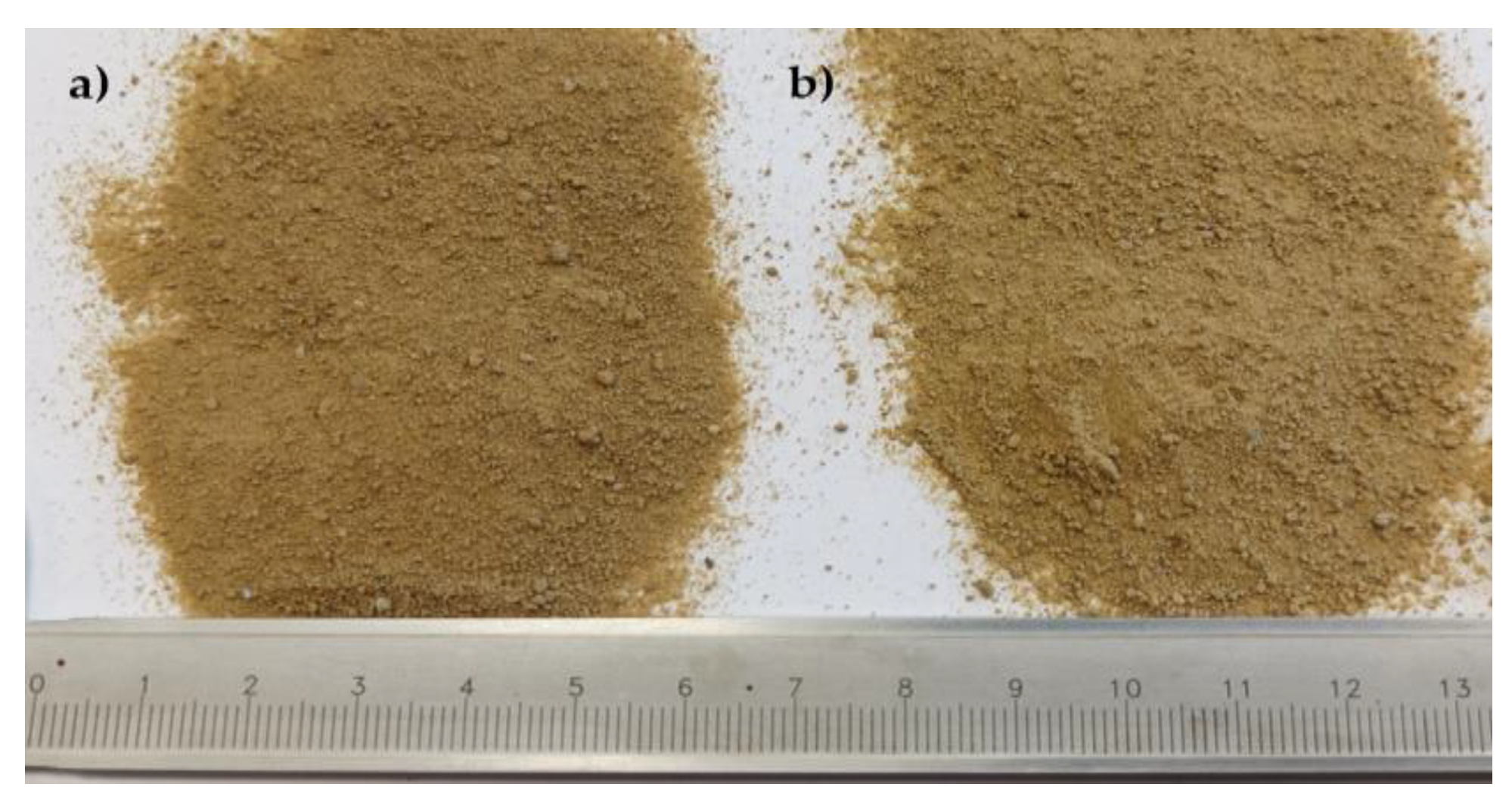

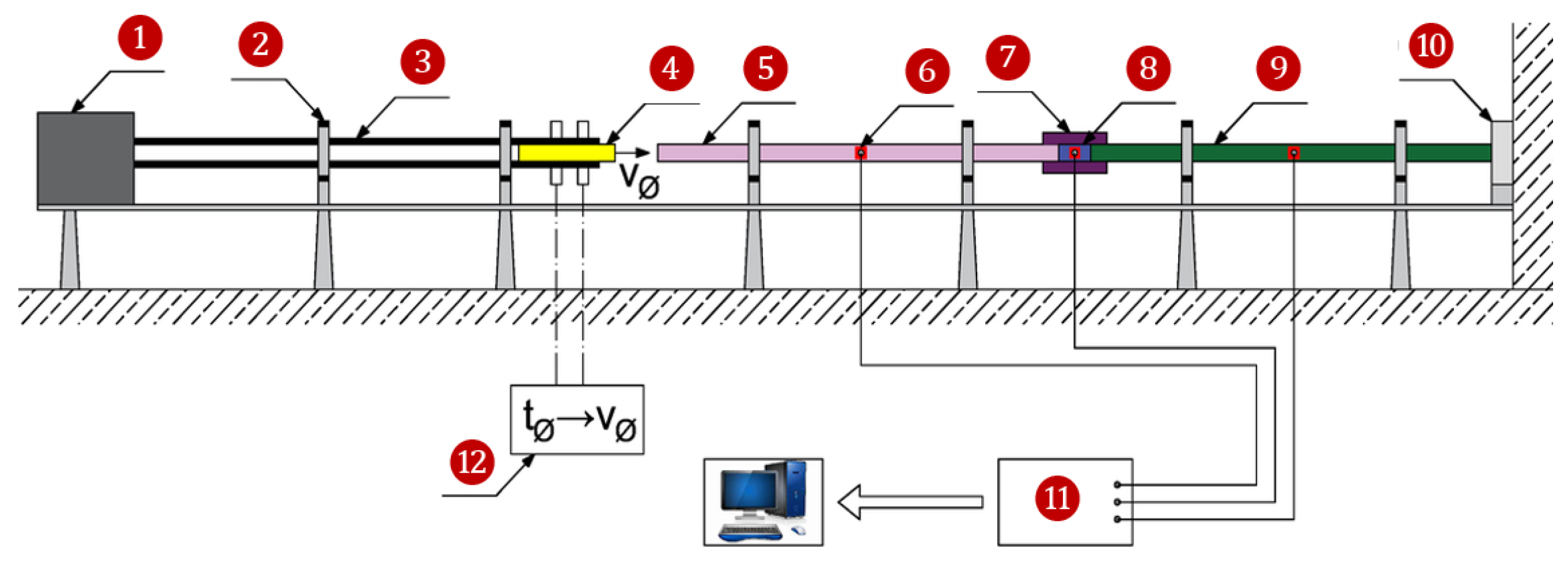


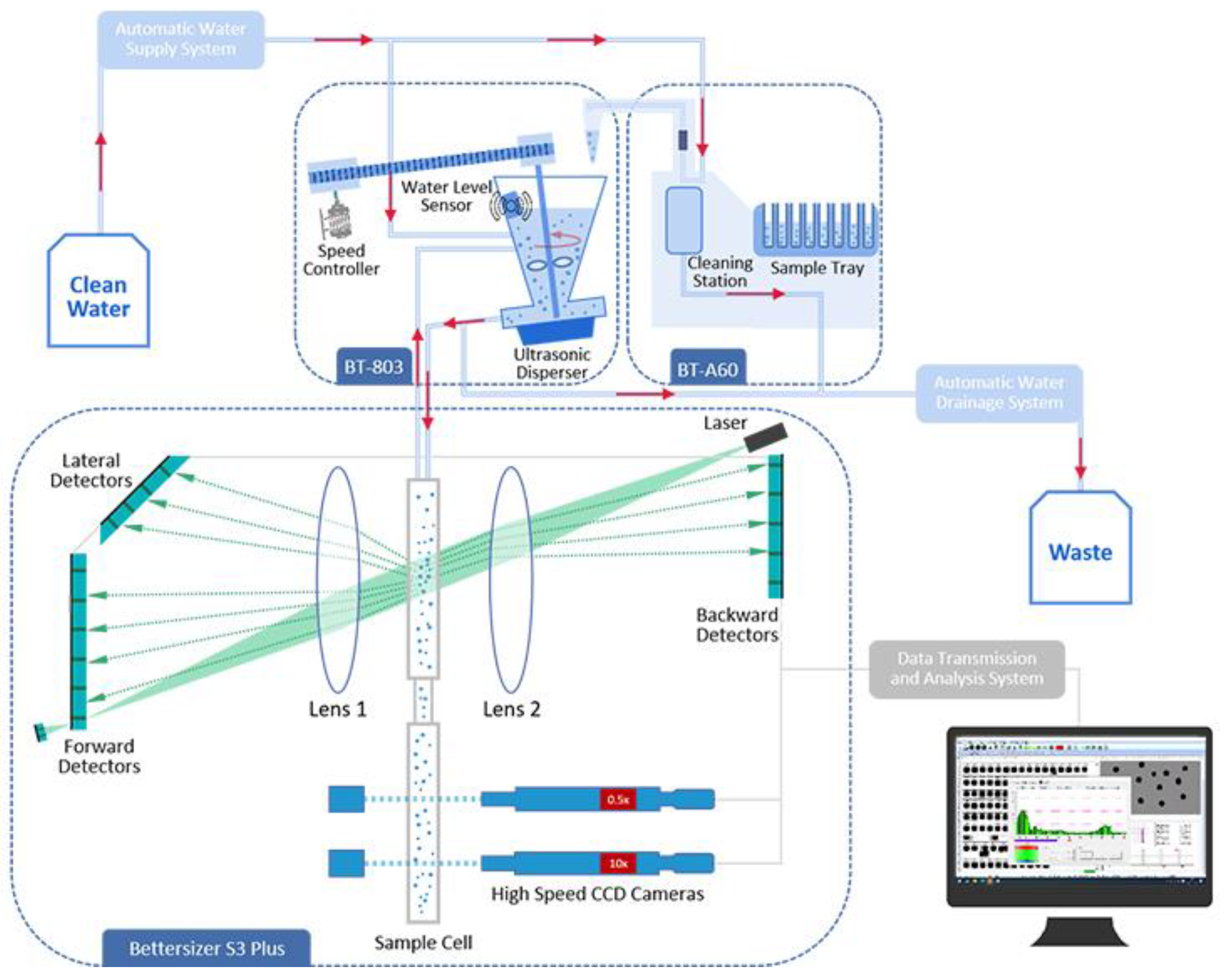
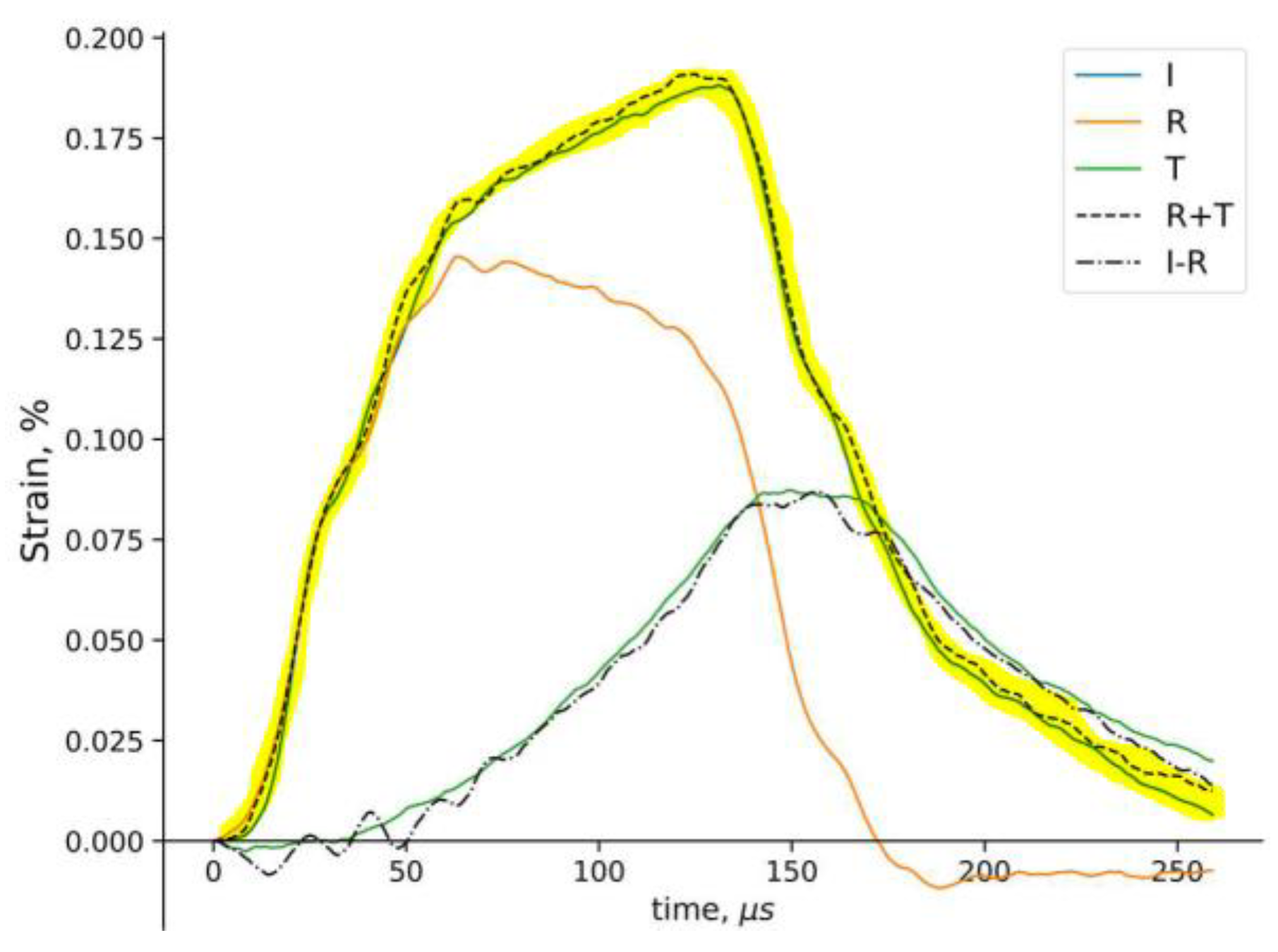
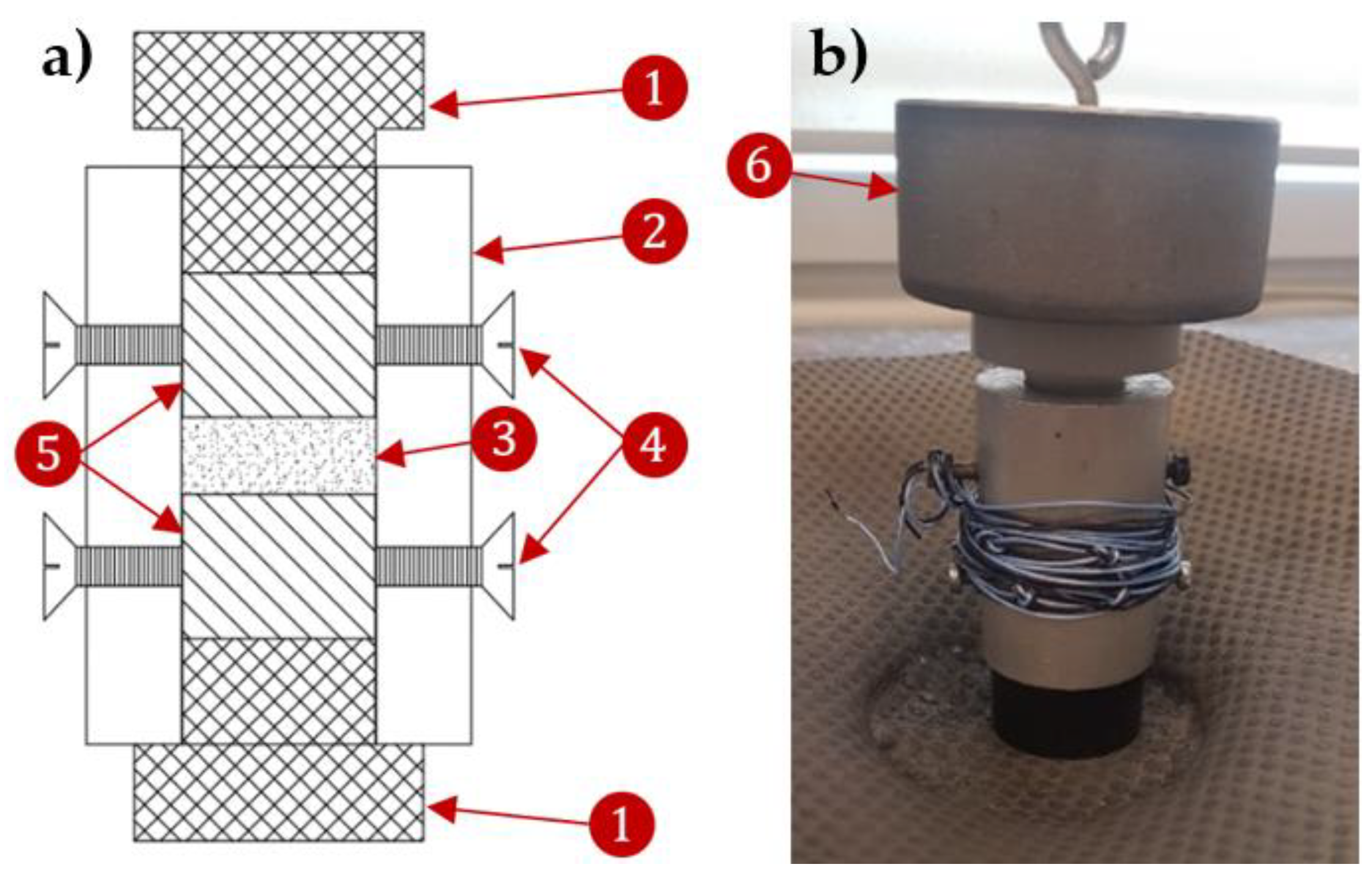


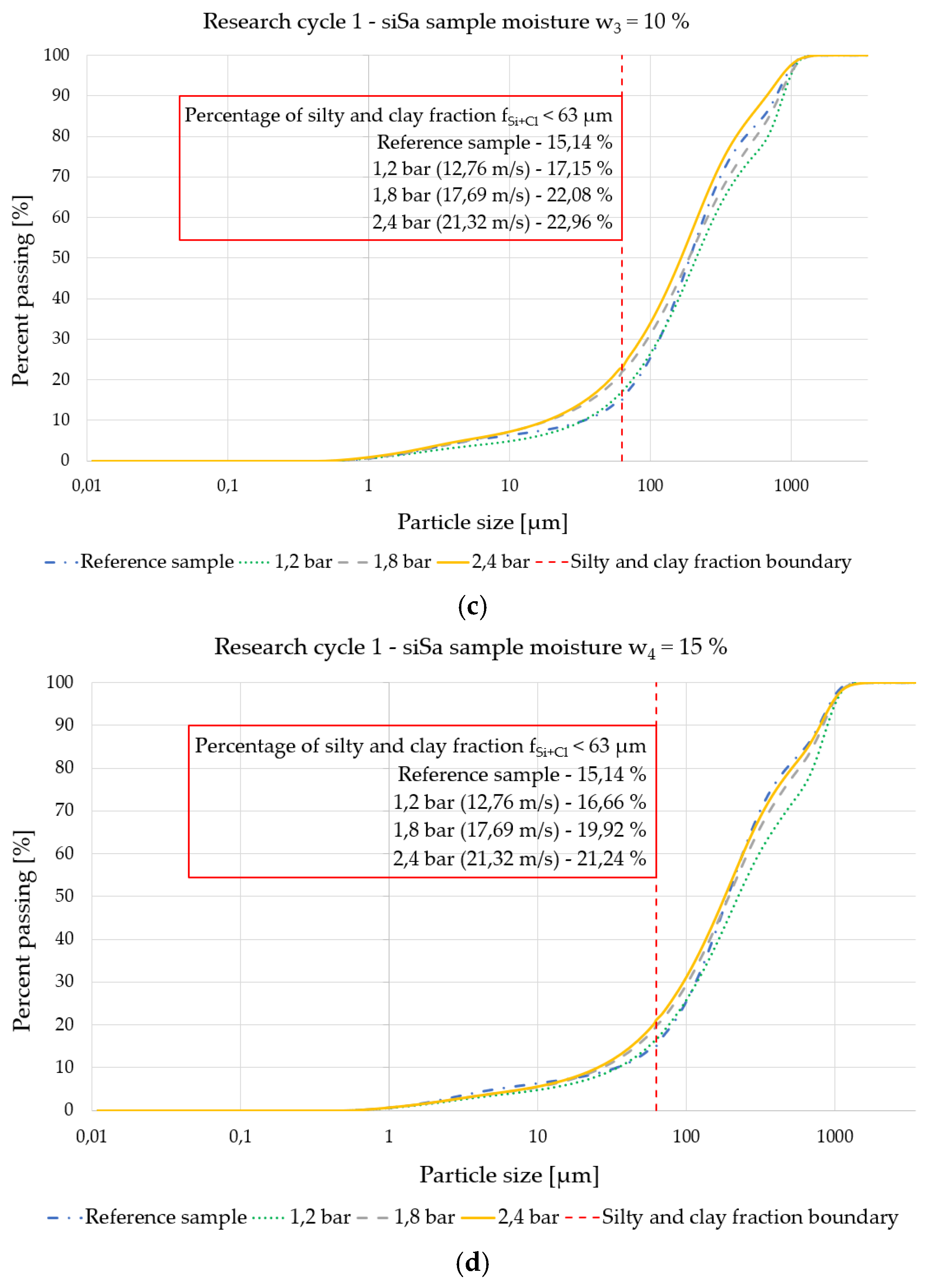
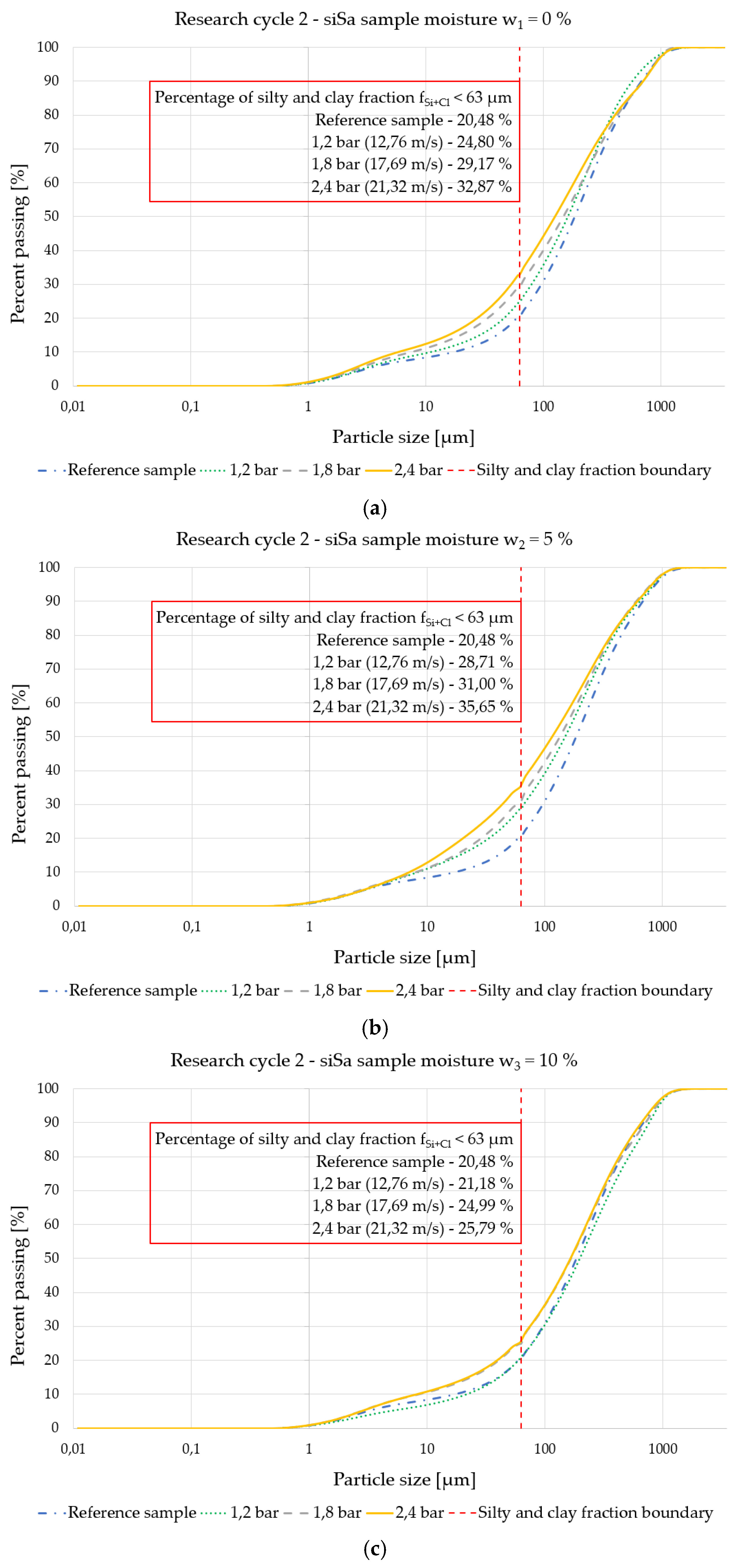
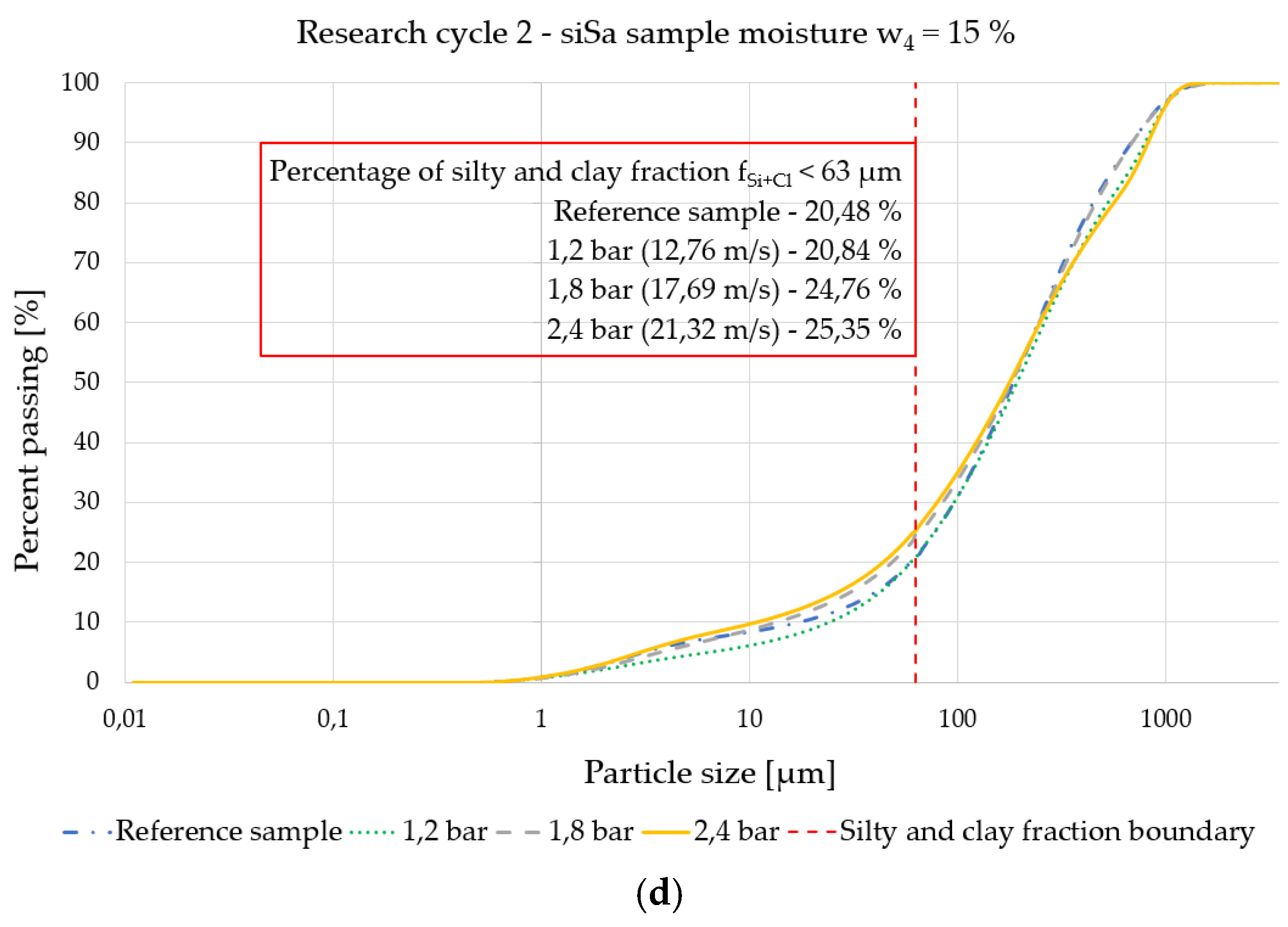
| Year | Web of Science | Springer Link |
|---|---|---|
| 2022 | 592 | 587 |
| 2021 | 538 | 456 |
| 2020 | 510 | 351 |
| 2019 | 486 | 359 |
| 2018 | 447 | 321 |
| Group I Non-Expansive Soils | Group II Poorly Expansive Soils (Doubtful Soils) | Group III Expansive Soils | Group IV Very Expansive Soils |
|---|---|---|---|
| Gravel (Gr) | silty sand (siSa) | sandy-silty clay (sasiCl) | clayey sand (clSa) |
| sand-gravel mix (grSa) | clayey gravel (clGr) | clay (Cl) | sandy silt (saSi) |
| coarse sand (CSa) | clayey sand-gravel mix (grclSa) | sandy clay (saCl) | silt (Si) |
| medium sand (MSa) | silty clay (siCl) | clayey silt (clSi) | |
| fine sand (FSa) |
| I | II | III | IV | V | VI | VII | VIII | IX | X | XI | XII |
|---|---|---|---|---|---|---|---|---|---|---|---|
| w1 = 0% | w2 = 5% | w3 = 10% | w4 = 15% | ||||||||
| p1 = 1.2 bar v1 = 12.76 m/s | p2 = 1.8 bar v2 = 17.69 m/s | p3 = 2.4 bar v3 = 21.32 m/s | p1 = 1.2 bar v1 = 12.76 m/s | p2 = 1.8 bar v2 = 17.69 m/s | p3 = 2.4 bar v3 = 21.32 m/s | p1 = 1.2 bar v1 = 12.76 m/s | p2 = 1.8 bar v2 = 17.69 m/s | p3 = 2.4 bar v3 = 21.32 m/s | p1 = 1.2 bar v1 = 12.76 m/s | p2 = 1.8 bar v2 = 17.69 m/s | p3 = 2.4 bar v3 = 21.32 m/s |
| I | II | III | IV | V | VI | VII | VIII | IX | X | XI | XII | XIII |
|---|---|---|---|---|---|---|---|---|---|---|---|---|
| w1 = 0% | w2 = 5% | w3 = 10% | w4 = 15% | |||||||||
| p1 = 1.2 bar v1 = 12.76 m/s | p2 = 1.8 bar v2 = 17.69 m/s | p3 = 2.4 bar v3 = 21.32 m/s | p1 = 1.2 bar v1 = 12.76 m/s | p2 = 1.8 bar v2 = 17,69 m/s | p3 = 2.4 bar v3 = 21.32 m/s | p1 = 1.2 bar v1 = 12.76 m/s | p2 = 1.8 bar v2 = 17.69 m/s | p3 = 2.4 bar v3 = 21.32 m/s | p1 = 1.2 bar v1 = 12.76 m/s | p2 = 1.8 bar v2 = 17.69 m/s | p3 = 2.4 bar v3 = 21.32 m/s | Reference sample |
| Reference Sample fSi+Cl | Moisture Content of the Silty Sand Sample wi | |||||
|---|---|---|---|---|---|---|
| w1 = 0% | w2 = 5% | w3 = 10% | w4 = 15% | |||
| fSi+Cl,1 = 15.14% | Launcher pressure pi/ Impact velocity vi | p1 = 1.2 bar v1 = 12.76 m/s | fSi+Cl,1-I = 16.64% | fSi+Cl,1-IV = 18.17% | fSi+Cl,1-VII = 17.15% | fSi+Cl,1-X = 16.66% |
| p2 = 1.8 bar v2 = 17.69 m/s | fSi+Cl,1-II = 23.58% | fSi+Cl,1-V = 23.97% | fSi+Cl,1-VIII = 22.08% | fSi+Cl,1-XI = 19.92% | ||
| p3 = 2.4 bar v3 = 21.32 m/s | fSi+Cl,1-III = 25.10% | fSi+Cl,1-VI = 26.22% | fSi+Cl,1-IX = 22.96% | fSi+Cl,1-XII = 21.24% | ||
| fSi+Cl,2 = 20.48% | p1 = 1.2 bar v1 = 12.76 m/s | fSi+Cl,2-I = 24.80% | fSi+Cl,2-IV = 28.71% | fSi+Cl,2-VII = 21.18% | fSi+Cl,2-X = 20.84% | |
| p2 = 1.8 bar v2 = 17.69 m/s | fSi+Cl,2-II = 29.17% | fSi+Cl,2-V = 31.00% | fSi+Cl,2-VIII = 24.99% | fSi+Cl,2-XI = 24.76% | ||
| p3 = 2.4 bar v3 = 21.32 m/s | fSi+Cl,2-III = 32.87% | fSi+Cl,2-VI = 35.65% | fSi+Cl,2-IX = 25.79% | fSi+Cl,2-XII = 25.35% | ||
| Launcher Pressure pi/ Impact Velocity vi | Moisture Content of the Silty Sand Sample wi/ Difference between fSi+Cl,1-k (fSi+Cl,2-k) and Reference fSi+Cl,1 (fSi+Cl,2) | |||||||
|---|---|---|---|---|---|---|---|---|
| w1 = 0% | Δ fSi+Cl,1-k − fSi+Cl,1 | w2 = 5% | Δ fSi+Cl,1-k − fSi+Cl,1 | w3 = 10% | Δ fSi+Cl,1-k − fSi+Cl,1 | w4 = 15% | Δ fSi+Cl,1-k − fSi+Cl,1 | |
| p1 = 1.2 bar v1 = 12.76 m/s | fSi+Cl,1-I = 16.64% | 1.50% | fSi+Cl,1-IV = 18.17% | 3.03% | fSi+Cl,1-VII = 17.15% | 2.01% | fSi+Cl,1-X = 16.66% | 1.52% |
| p2 = 1.8 bar v2 = 17.69 m/s | fSi+Cl,1-II = 23.58% | 8.44% | fSi+Cl,1-V = 23.97% | 8.83% | fSi+Cl,1-VIII = 22.08% | 6.94% | fSi+Cl,1-XI = 19.92% | 4.78% |
| p3 = 2.4 bar v3 = 21.32 m/s | fSi+Cl,1-III = 25.10% | 9.96% | fSi+Cl,1-VI = 26.22% | 11.08% | fSi+Cl,1-IX = 22.96% | 7.82% | fSi+Cl,1-XII = 21.24% | 6.10% |
| Δ fSi+Cl,2-k − fSi+Cl,2 | Δ fSi+Cl,2-k − fSi+Cl,2 | Δ fSi+Cl,2-k − fSi+Cl,2 | Δ fSi+Cl,2-k − fSi+Cl,2 | |||||
| p1 = 1.2 bar v1 = 12.76 m/s | fSi+Cl,2-I = 24.80% | 4.32% | fSi+Cl,2-IV = 28.71% | 8.23% | fSi+Cl,2-VII = 21.18% | 0.70% | fSi+Cl,2-X = 20.84% | 0.36% |
| p2 = 1.8 bar v2 = 17.69 m/s | fSi+Cl,2-II = 29.17% | 8.69% | fSi+Cl,2-V = 31.00% | 10.52% | fSi+Cl,2-VIII = 24.99% | 4.51% | fSi+Cl,2-XI = 24.76% | 4.28% |
| p3 = 2.4 bar v3 = 21.32 m/s | fSi+Cl,2-III = 32.87% | 12.39% | fSi+Cl,2-VI = 35.65% | 15.17% | fSi+Cl,2-IX = 25.79% | 5.31% | fSi+Cl,2-XII = 25.35% | 4.87% |
Disclaimer/Publisher’s Note: The statements, opinions and data contained in all publications are solely those of the individual author(s) and contributor(s) and not of MDPI and/or the editor(s). MDPI and/or the editor(s) disclaim responsibility for any injury to people or property resulting from any ideas, methods, instructions or products referred to in the content. |
© 2023 by the authors. Licensee MDPI, Basel, Switzerland. This article is an open access article distributed under the terms and conditions of the Creative Commons Attribution (CC BY) license (https://creativecommons.org/licenses/by/4.0/).
Share and Cite
Sobczyk, K.; Chmielewski, R.; Kruszka, L.; Rekucki, R. Analysis of the Influence of Silty Sands Moisture Content and Impact Velocity in SHPB Testing on Their Compactability and Change in Granulometric Composition. Appl. Sci. 2023, 13, 4707. https://doi.org/10.3390/app13084707
Sobczyk K, Chmielewski R, Kruszka L, Rekucki R. Analysis of the Influence of Silty Sands Moisture Content and Impact Velocity in SHPB Testing on Their Compactability and Change in Granulometric Composition. Applied Sciences. 2023; 13(8):4707. https://doi.org/10.3390/app13084707
Chicago/Turabian StyleSobczyk, Kamil, Ryszard Chmielewski, Leopold Kruszka, and Ryszard Rekucki. 2023. "Analysis of the Influence of Silty Sands Moisture Content and Impact Velocity in SHPB Testing on Their Compactability and Change in Granulometric Composition" Applied Sciences 13, no. 8: 4707. https://doi.org/10.3390/app13084707
APA StyleSobczyk, K., Chmielewski, R., Kruszka, L., & Rekucki, R. (2023). Analysis of the Influence of Silty Sands Moisture Content and Impact Velocity in SHPB Testing on Their Compactability and Change in Granulometric Composition. Applied Sciences, 13(8), 4707. https://doi.org/10.3390/app13084707







